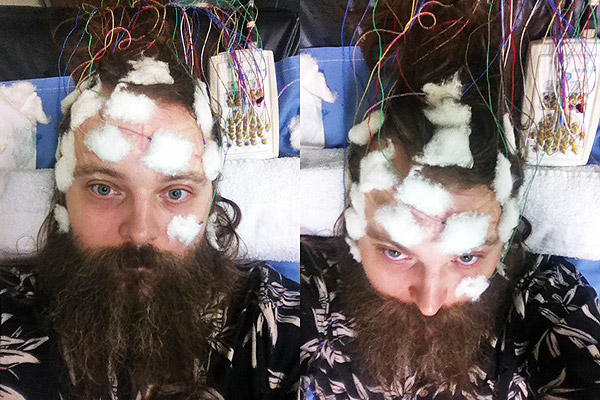I had my EEG this morning, which was less interesting than I had hoped. It was a sleep deprived EEG to investigate my central apnea (where my brain ceases to notice CO2 buildup and thus stops sending the signal to breathe) and other neurological problems stemming from either my genetic disorder or the treatment thereof. I had to stay up for twenty-four hours beforehand, which I managed to do in part by following Caitlin’s advice of setting hourly alarms just in case I dozed off (which I admit may have saved twenty minutes of sleep from turning into five hours of sleep). For those wondering about my heart, the test was only thirty minutes long with all of it directed (ie. do this, don’t do that), and didn’t involve an ECG hookup, so there was no opportunity for the experiment anyway.

Ignoring the apnea in which my breathing can stop for up to five minutes at a time, my normal breathing rate is three or four breaths per minute, which I have read is actually a very healthy rate and allows your body to survive about eight minute pauses in breathing without major issues (not that you ever want an eight minute pause in breathing!!!). The old woman administering the test at one point asked me to breath normally and indicated her idea of “normal” by loudly breathing and expecting me to synchronize with that. I don’t know if she was unhealthy or something, but she was deeply breathing a solid twenty times a minute! She kept saying “breathe faster! breathe faster!” and I was like, “I’m going to get light headed, you’re making me hyperventilate here!”… That’s why when I got home I did some reading on normal rates, as she got me worried that I was starving myself of oxygen or something, but it seems to me that my rate of breathing is perfectly fine for a resting person. Luckily she is not the doctor interpreting the EEG. I guess I will know the results within a month or so.
Speaking of medical stuff, I am extremely upset at Ontario’s decision to take Oxycodone/Oxycontin off the shelves!!! I am not on that particular pain medication, but I have been in the past, and it was a literal lifesaver, and was the best tool that my doctor had to keep me from choosing to off myself from the pain (and I am not exaggerating in any way, and I have read similar statements in pain forums online). The fact that the medical system is more concerned with the criminal abuse of misdirected medication than with getting medication into the hands of patients that desperately need it is backwards and cruel to say nothing of ineffective.
The reality is that in many markets heroin is cheaper and more readily available than Oxys. Because I spent a year dramatically underprescribed before my diagnosis set in stone the fact that I was in tremendous physical pain, I am well aquainted with self-medication and the black market for opiates. This is no secret to my doctors, so I am not afraid or ashamed to write it publicly — I consider it a shortcoming in the medical system, not in myself. In any case, when it comes to recreational users and addicts, if you reduce the supply of oxycontin, all you do is shift these people over to heroin. So you have just as many drug addicts, but you connect them more deeply to the international drug world. In addition, you shift people from a pharmaceutically manufactured drug where they know the exact quantity to a street drug of unpredictable safety, quality, and strength, thereby increasing overdoses and other health complications. Also, Oxycodone has been carefully engineered to be highly effective orally. There is limited improvement from injecting it or even snorting it (it’s mostly a habit or psychosomatic difference). Heroin on the other hand is not particularly effective orally and should be smoked or injected. So you’re also changing users from pill-poppers into injection drug users, with all the problems that come with that, from the simple damage of repeated injections and potential infections on up to shared needle risks such as hepatitis and AIDS. Finally, for those that choose to stick with oxy (and you can bet that there will be increased importation, which also strengthens the criminal world), costs will rise, which increases the financial damage to the users which harms their lives and causes them to commit crimes such as theft at an increased rate. So when you look at the effect oxycontin supply limitation will have on the criminal aspect, it’s a deeply negative one.
But let’s look at who is really hurt — genuine patients. Oxycontin is popular because it works. For most people it is the most effective medication for pain relief in pill form on the market. Barring overdose (which will not happen if used responsibly), it is extremely safe with far less side-effects than most other pain medications. I definitely concede that abuse can lead to addition — that’s a genuine problem — but the fact is that it’s very effective, inexpensive, and safe. Taking this away from people who need it is profoundly cruel. People who are in the amount of pain that necessitates this medication are in living hell. Often this is the only thing that keeps them alive. I’ve read that people on this medication are either being taken off it completely or being moved to buprenorphine formulations, which is a drug used to ween people off opiates that also has some pain relief side-effects. It is however far, far, far less effective, and perhaps more importantly, it is also much more expensive — potentially changing a bill from a hundreds of dollars a month to thousands of dollars a month. This makes me wonder what role the pharmaceutical lobby has played in this decision. And of course the drug can be abused as well, although with greater risk. If I was still on oxy and it was my only effective option (I’m on a different course of treatment), and this happened to me, I think I would strongly consider going to the College of Physicians or whoever made this decision and burning myself to death with gasoline on their doorstep in protest. I have heard similar musings in pain forums online. That’s how much this matters to patients — it is a life-or-death issue, and it seems to me that this ill-conceived decision has no good effect on either the criminal element or on legitimate pain patients. It’s cruel, ineffective, and harmful, with the emphasis being on cruel.

And all this is to say nothing of the fact that both smoking cigarettes and drinking alcohol are statistically far, far, far more devastating to our society than the abuse of prescription opiates.
I have to wonder who the uncaring moralistic monster is that made this happen is and what short-sighted reasoning made it happen. It’s heart-breaking that there are so few people out there advocating for pain patients, who are often not in a position to be able to do so themselves as they struggle to just get out of bed.









